Next.js 13

Exploring the Next.js 13 Framework: Powering the Future of Web Development.
Introduction
In the ever-evolving landscape of web development, staying updated with the latest tools and frameworks is crucial to delivering high-performance and user-friendly applications. One such tool that has garnered significant attention and popularity is Next.js 13. With its cutting-edge features and improvements, Next.js 13 is poised to shape the future of web development, offering developers a powerful platform to build modern web applications.
Introducing Next.js 13: A Brief Overview
Next.js, developed by Vercel, is a widely-used React framework that aims to simplify the process of building production-ready web applications. Its latest iteration, Next.js 13, introduces a host of features that elevate the framework's capabilities, enabling developers to create faster, more efficient, and visually appealing web applications.
Key Features of Next.js 13:
1. Incremental Static Regeneration (ISR):
One of the standout features of Next.js 13 is its enhanced support for Incremental Static Regeneration. ISR allows developers to pre-render static pages at build time while also allowing for subsequent updates to those pages at runtime. This means that not only can web pages load faster, but also remain dynamic by updating content without requiring a full regeneration.2. Hybrid SSG and SSR:
Next.js 13 offers a seamless combination of both Server-Side Rendering (SSR) and Static Site Generation (SSG). This hybrid approach empowers developers to choose the optimal rendering strategy for each specific page, optimizing performance while maintaining interactivity and SEO-friendliness.3. Faster Start Times:
With Next.js 13, reduced start times are a reality. The framework's enhanced performance optimizations ensure that applications load quickly, providing a smoother and more engaging user experience.4. Image Optimization:
Visual content plays a crucial role in web applications, and Next.js 13 addresses this by providing advanced image optimization. Developers can effortlessly handle various image formats, automatically generating responsive images of different resolutions to cater to diverse devices and screen sizes.5. Improved Developer Experience:
Next.js 13 focuses on enhancing the developer experience through features like Fast Refresh, which speeds up the development process by providing real-time updates without a full page reload. Additionally, the framework's intuitive API routes enable developers to create serverless functions that integrate seamlessly with their applications.6. Automatic Webpack 5 Migration:
With the adoption of Webpack 5, Next.js 13 introduces improved performance, better tree-shaking capabilities, and enhanced caching mechanisms, resulting in faster build times and optimized bundles.7. Tailwind CSS Integration:
Recognizing the popularity of utility-first CSS frameworks like Tailwind CSS, Next.js 13 offers built-in support for Tailwind CSS, making it easier for developers to create stunning and responsive designs.Why Choose Next.js 13?
The adoption of Next.js 13 brings numerous advantages to web developers:
1. Optimized Performance:
The hybrid rendering approach, combined with advanced optimizations, ensures that applications built with Next.js 13 are faster and more efficient, leading to better user experiences.2. Flexible Rendering Strategies:
Next.js 13 provides developers with the flexibility to choose between SSR and SSG based on the specific requirements of each page, striking a balance between performance and interactivity.3. Streamlined Development:
The framework's features, such as Fast Refresh and API routes, streamline the development process, allowing developers to create feature-rich applications more efficiently.4. SEO-Friendly:
With its support for server-side rendering and static site generation, Next.js 13 ensures that web applications are easily discoverable by search engines, enhancing their SEO performance.5. Future-Proof Technology:
Next.js 13 stays at the forefront of web development trends by adopting technologies like Webpack 5 and offering features that align with modern best practices.Conclusion
In conclusion, Next.js 13 is a game-changing framework that empowers developers to create high-performing, visually appealing, and interactive web applications. With its versatile rendering strategies, advanced optimizations, and enhanced developer experience, Next.js 13 is well-positioned to shape the future of web development, catering to the demands of modern users and developers alike. Whether you're building a dynamic e-commerce platform, a content-rich blog, or a business portfolio, Next.js 13 has the tools and capabilities to bring your vision to life in the digital realm.
Want to take the next step ?